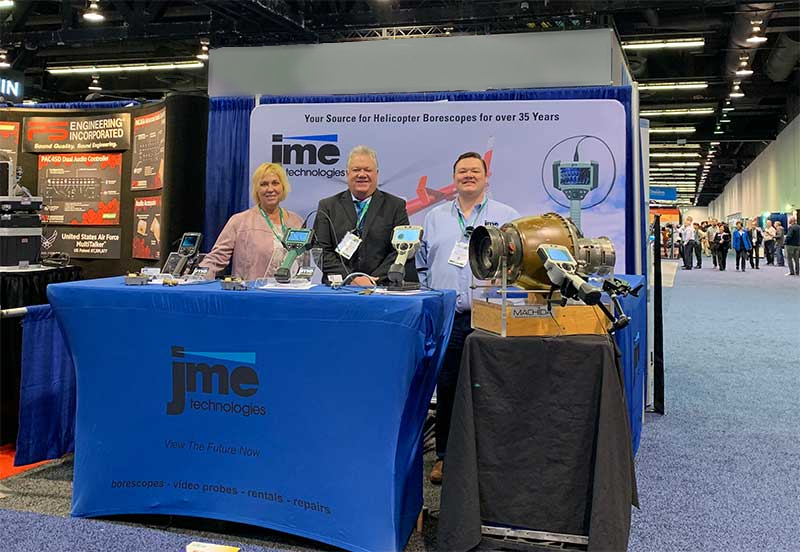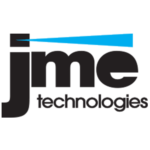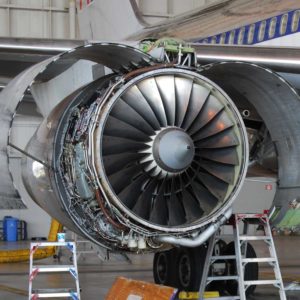What is a Borescope?
A borescope is an optical instrument designed as a form of Non-Destructive Testing (NDT). Borescopes (also sometimes called a boroscope) assists visual inspection of areas which would otherwise need to be disassembled to be properly inspected. Perfect for visually inspecting hard-to-reach, narrow cavities, borescopes consist of a rigid or flexible tube with a display or eyepiece on one end and a camera on the other. Borescopes commonly use a relay lens system, a rod lens system, a fiber optic image guide, or a CCD or CMOS Camera Chip. Most commonly used in the aviation industry to inspect gas turbine engines, borescopes help make a dangerous job safer and easier.
What are Borescopes Used for?
Borescopes are extremely useful for visual inspection of hard-to-see areas or inaccessible areas. Instead of destructive or other time-consuming and expensive dismounting work, borescopes provide a way to identify problems or defects in a nondestructive way. Borescopes are huge time and money savers, but also provide a way to safely work with gas turbines. Commonly used to inspect aircraft engines, industrial turbines, diesel engines and automotive engines, borescopes help prevent unnecessary maintenance and expense. Borescopes can also be used during the manufacturing process to inspect for critical imperfections.
Borescopes are used in many industrial applications, especially gas turbine engine inspection. They are most commonly used in the aviation industry because the gas turbine inspection procedure can be extremely dangerous (with temperatures around 2,000 degrees Fahrenheit) borescopes provide a way to safely inspect gas turbines.
Borescopes are also used in other industries such as
● Electric and power industry
● Aviation
● Chemical
● Special Survey
● Automotive
● Ships and Boats
Types of Borescopes
The most common borescopes have two types of probes: rigid and flexible. Each of these types have their own unique pros and cons. Choosing the right borescope for a job depends on the specific application and what the end goal is.
Rigid Borescopes
Rigid borescopes are made of a stainless steel probe and do not bend or fold in the probe because they use lens or fibers to relay an optical view to the camera or eye piece. Rigid borescopes often provide a higher quality image at a lower cost compared to a flexible borescope. However, rigid borescopes are limited to what they can access because they are a straight line. There are a variety of different optical systems and lens sizes available.
Flexible Borescopes
Flexible borescopes typically include a metal weave that protects the insides of the probe that contain either fiber optics or electrical cable to relay the information; additionally, if it has articulation, the articulation wires will also be fed through the length of the probe to where the articulation controls are. The articulation wires are very thin metal wires similar to piano wires that push and pull in order to move the head of the scope one direction or another.
Traditional flexible borescopes have a bundle of optical fibers (also known as a fiberscope) and can access cavities around a bend. Because the fibers divide the image into pixels, traditional flexible borescopes can suffer from pixelation and lower image quality. Among different models of flexible borescopes, image quality can vary greatly. The best flexible borescope for a job depends on the specific application. Some high end flexible borescopes have better image-capturing technology, better field of view and a wider range of articulation.
Borescopes also need a light source for many applications to allow the view from the probe to be well lit enough to see. Rigid and fiber scopes also need a light source to be shot through the body of the probe through fiber optics; however, many of the flexible video probes do not use fiber optics, instead they use LEDs that are electronically installed on the tip of the probe, next to the lens. These illuminate dark spaces and improve image quality.
Video Borescope
A video borescope, also known as an “inspection camera,” is similar to a flexible borescope but also uses a mini video camera at the end. At the same end as the camera, there’s also a light source to help give clarity and control when capturing images in dark spaces. It displays the captured images at the other end.
How to Select the Right Borescope
It is important to understand what kind of borescope you will need for each particular application. First, figure out what kind of borescope you need: a rigid or flexible probe.
Then you need to determine the correct size of borescope you would need to do the inspection. Our most common sizes sold are 4, 6 and 8mm, but we offer a 2.4mm in a flexible video probe or even smaller in a semi rigid. We suggest getting the largest diameter you can to get the job done and for the borescope to fit into any hole comfortably with little wear and tear. The easier the inspection is to do on the scope, the longer it will last.
The length is important as well. Without the right amount of length, you won’t be able to reach the place you need to inspect, but too much length can get in the way, especially when climbing ladders or in the field. Determine the distance needed to reach the specific areas you need to assess and give yourself a small margin for extra.
JME Technologies is proud to offer the highest quality borescopes in the industry. We manufacture and supply the largest selection of high quality borescopes. Our product range includes diameters 0.6mm to 10mm in lengths up to 30m. Hundreds of borescopes are available to match your specific application. Search our website or contact us to learn more.



